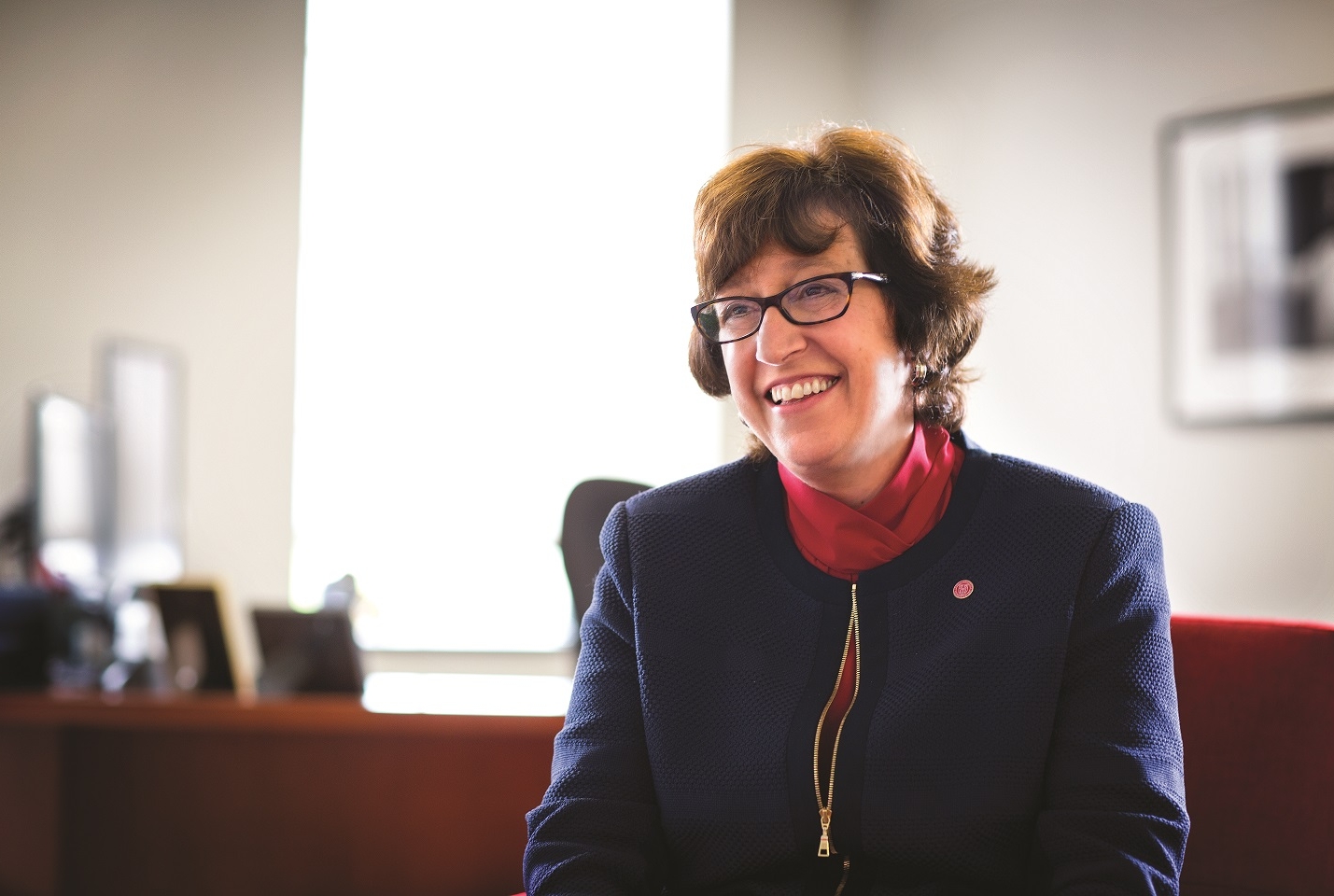Portrait by Robert Barker
Martha Pollack, PhD, Cornell’s 14th president, took office in April; she came from the University of Michigan, where she’d served for 17 years in several roles including dean of the School of Information and provost, a position that included overseeing the university’s medical school. A native of Stamford, Connecticut, Pollack holds an undergraduate degree from Dartmouth and a doctorate in computer and information science from Penn. She and her husband, Ken Gottschlich, a jazz musician and engineer, have two grown children. Cornell’s second female president, Pollack succeeds Elizabeth Garrett, who passed away in March 2016.
You have spent your first months in office on a self-described listening and learning tour of the university. What are the most important things you have learned so far, both about Cornell in general and Weill Cornell Medicine in particular?
In my first 100 days at Cornell, I have sought out as many students, faculty members and staff as possible, on our Ithaca and New York City campuses. I’ve spoken with alumni living around the globe. I’m learning what matters most to our community as I formulate my vision and priorities. These discussions have reinforced my view that Cornell is a truly extraordinary university, unrivaled in the scope and excellence of our teaching, research and outreach.
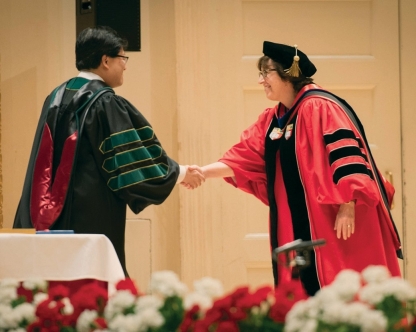
Pollack with Dean Dr. Augustine M.K. Choi at her first Weill Cornell Medicine commencement in May. Photo credit: Ameilia Panico
We are distinguished by our land-grant mission of “knowledge for the public good,” and by our long-standing commitment to diversity and inclusion — Cornell has been open to women, minorities and international students from its founding more than 150 years ago. Cornell is also the only institution that bridges upstate and downstate New York. In Ithaca, we’re a close-knit community of scholars, gathered in a special place that resonates deeply with alumni. In New York City, we are linked to the world’s greatest city, offering unparalleled opportunities for our students and scholars. Weill Cornell Medicine is our largest footprint in the city, with a long history of providing high-quality patient care, making biomedical discoveries that translate to new therapies and educating exceptional doctors and scientists.
What makes Cornell unique among the ivies?
As a member of the presidential search committee told me, Cornell is an Ivy League school with a Big Ten heart. Coming from the University of Michigan, I have found that to be a very fitting description. We stand out in higher education as the only Ivy League university with a land-grant mission. Cornell is defined by several key traits: the highest possible academic quality, a commitment to core liberal arts and professional education, and outreach and engagement for social good — values embodied by our Ithaca programs, as well as those at Weill Cornell Medicine and Cornell Tech.
Ensuring diversity was an integral part of your role as provost at Michigan. How are you applying that commitment to Cornell University?
With Ezra Cornell’s founding pledge of “any person. . . any study,” Cornell has shown a deep, abiding commitment to diversity from day one. It is an extraordinary vision when you consider the social landscape of 1865, and today Cornell continues to be a national leader in establishing an inclusive campus climate.
Cornell has an active University Diversity Council, which includes two administrators from Weill Cornell Medicine and advances the university’s strategic goals for faculty, student and staff diversity. This work extends to colleges and units through a framework we developed called Toward New Destinations, which fosters grassroots initiatives in support of our core principles of composition, engagement, inclusion and achievement. As president, I hope to double down on extending this legacy, fostering a climate that embraces differences and provides rich opportunities for learning from those differences.
I am also taking a strong stance on Cornell’s commitment to free speech. We are a community where all voices may be heard and where the dignity of all individuals is protected. A diverse community includes everyone and is the foundation for the free exchange of ideas.

Pollack at the Ithaca campus’s Commencement ceremony in May. Photo credit: Jason Koski/ Cornell Marketing Group
You have credited mentors in your life for cultivating you into a successful leader. How are you encouraging mentorship at Cornell, and why is it important for student and faculty development?
Like many undergraduates, I began college unsure of my career trajectory. I liked math and thought that would be my major. For an elective requirement, I took an anthropology course and loved it. I went to the professor with a crazy idea for a dual major in math and anthropology. After some conversation, I ultimately landed on linguistics as blending my interests in the sciences and humanities. That conversation changed my life, setting me on a path to become an academic, to work with students and do my best to inspire them, and I remain indebted to that professor, who became my undergraduate adviser.
As with many facets of Cornell, the key ingredient is our faculty. At the Merrill Presidential Scholars luncheon — when outstanding seniors honor both a faculty member and a high school teacher who influenced them — I spoke to students who credit our professors with sparking their passion for discovery and learning. And I have heard stories from countless alumni about Cornell mentors who transformed their lives. It’s a thread that unites faculty across Cornell — from introductory classes in Ithaca to a Cornell Tech open studio in which students present their work to professors and industry mentors, or a Weill Cornell Medicine clinical setting — this desire to give our students a world-class education.
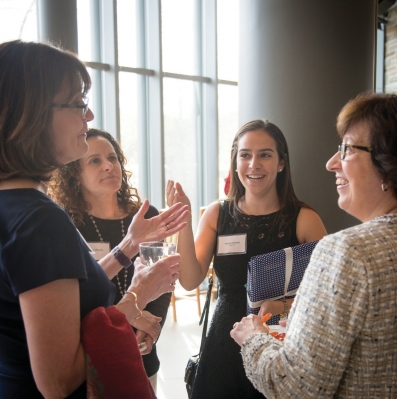
Pollack chatting with students and faculty on the Ithaca campus. Photo credit: Jason Koski
Your background is in computer science, particularly intelligent technology designed to help people with cognitive impairments. Given your knowledge and experience in this area, how do you think technology can contribute to improving human health?
My background includes algorithmic work on plan recognition and plan formation — how a computer or robot can form a plan to achieve certain actions. I wanted to use that work to benefit people directly, through assistive technology, and one of my projects involved working with people with serious cognitive impairment from illness or injury. We used sensor technology and AI algorithms to analyze the steps they used in carrying out a task, and that information helped us understand their executive functioning.
Cornell researchers are demonstrating many other ways that technology can contribute to improving health. At Cornell Tech, students earning a Technion-Cornell dual master’s in health tech are honing their technological skills and knowledge to meet the needs of the healthcare system. Also at Cornell Tech, the Small Data Lab — directed by Professor Dr. Deborah Estrin, who is also a public health professor at Weill Cornell Medicine — creates apps that use private data traces to provide insights and assist individuals with health- related decisions.
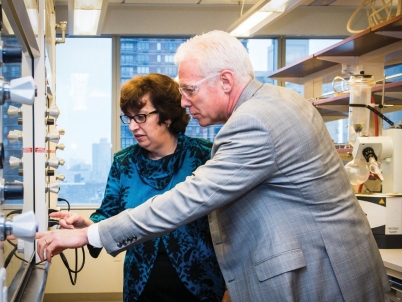
Pollack getting a laboratory tour from Dr. Michael Foley, director of the Tri- Institutional Therapeutics Discovery Institute. Photo credit: Studio Brooke
The HRH Prince Alwaleed Bin Talal Bin Abdulaziz Al-Saud Institute for Computational Biomedicine at Weill Cornell Medicine is also doing interesting work with mathematical modeling and large-scale data analysis to deal with complex medical problems — for instance, by studying genomes and physiological systems. Many other Weill Cornell Medicine institutes are immersed in advanced technologies. And all of this work contributes to the Weill Cornell Medicine mission by enhancing the quality of patient care and the value of research.
We are hearing a lot about the importance of strengthening and expanding collaborations between Cornell’s campuses. Why are these bridges, especially between Ithaca and New York City, so important for Cornell and for this moment in higher education?
This month, we will dedicate the Cornell Tech campus on Roosevelt Island. It’s an exciting moment for Cornell to be at the forefront of New York City’s evolving ecosystem for tech entrepreneurship. Cornell’s growth on Roosevelt Island is underpinned by decades of work in New York City — primarily by Weill Cornell Medicine, which, with its ties to NewYork-Presbyterian and other top-flight facilities, is part of a robust scientific corridor known for innovative clinical care and research. I expect we’ll see many joint projects by Weill Cornell Medicine and Cornell Tech researchers in areas like bioinformatics and health technology. At the same time, many of our Ithaca colleges and schools offer academic and research programs in the city, and Cornell Cooperative Extension delivers knowledge to residents across the five boroughs.
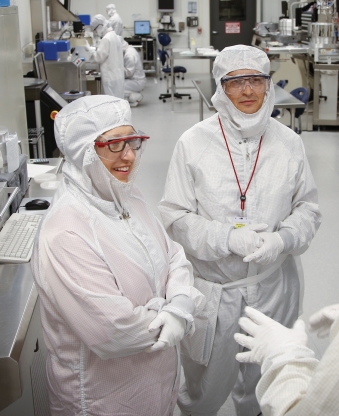
Pollack at Cornell's Employee Assembly. Photo credit: Jason Koski
I am discovering an abundant interest by faculty, students and staff in building synergies between our upstate and downstate campuses. For example, the Hinge Project supports Ithaca-based faculty, primarily from the humanities, policy and social sciences, who want to teach or conduct research in New York City. As vice dean focused on academic integration, Dr. Gary Koretzky helps to foster collaborations in genetics, computational biology and data sciences. Weill Cornell Medicine is currently expanding its rural residency program with partners in Ithaca. There is a major — and growing — flow of information, people, ideas and opportunities in both directions.
You have spoken of the need for evidence to shape both science and public policy, and for the public to support scientific ways of evaluating evidence. How will you lead Cornell’s efforts to both drive national dialogue and advocate for public policy that’s grounded in evidence?
You don’t have to be a scientist to recognize how important it is to use solid evidence rather than simply ideology to make decisions about public policy — or about your own individual beliefs. Cornell and other colleges and universities have an important role to play in promoting evidence-based reasoning. We do that, first of all, in the way we educate our students. Our faculty emphasize the value of critical thinking, clear written and oral communication, and reasoned, respectful debate. Cornell also disseminates knowledge beyond our campuses — through outreach programs like Cooperative Extension, by making faculty expertise available to the media, and by conducting research and publicizing research results. Our democracy depends on informed, reasoning citizens and in an age of media overload, higher education must combat the tendency to accept unsubstantiated assertions as truth.
What do the current uncertainties around federal funding for research in science and medicine mean for the future of research and our society?
Following World War II, the federal government began investing heavily in its research and development partnership with American universities. This enduring partnership has yielded discoveries that have improved millions of lives around the world; trained leaders in science, technology, engineering and mathematics; and bolstered the United States economy and defense. Innovations such as the Internet, treatments for deadly chronic diseases and deeper understandings of genetics, plant sciences, artificial intelligence and more arose from university research.
Cornell is very much a part of that scenario — home to more than 100 interdisciplinary research organizations and programs, major research centers such as the Atkinson Center for a Sustainable Future and the Cornell Lab of Ornithology and two national research centers, the Cornell High Energy Synchrotron Source and the Cornell NanoScale Facility. Weill Cornell Medicine is a research powerhouse that attracted more than $120 million in National Institutes of Health funding last year in support of life-saving discoveries.
Cuts to federal funding pose a significant threat to our ability to sustain this research infrastructure, harming America’s stature as a leader in technological and economic advancement. We must renew and strengthen government-university partnerships if we wish to continue to advance American science, serve the public good and educate and train the next generation of thinkers required to move our nation forward.
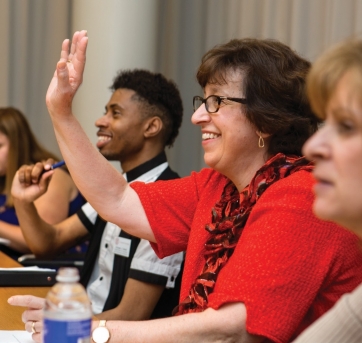
Touring a “clean room” at the Cornell NanoScale Facility in the College of Engineering. Photo credit: Lindsay France/Cornell Marketing Group
Cornell has dramatically expanded its global reach in recent decades on a variety of fronts, including Weill Cornell Medicine’s affiliations with medical schools and clinics worldwide. How important is this global focus for Cornell?
Through our Global Cornell Initiative, Vice Provost Laura Spitz is doing a brilliant job to coordinate efforts, develop standards and nurture innovation in international engagement. Our undergraduates have a wealth of opportunities for global learning. In graduate and professional student education, we attract top minds from the international community. Weill Cornell Medicine–Qatar is a pioneer of medical education, improving patient care, biomedical research and quality of life in the Mideast.
We also bring a global perspective to our research and outreach mission. In dozens of countries, Cornell faculty and students lead projects to improve human health, fight inequality and develop new energy solutions. We translate these findings for the direct benefit of resource-starved developing nations, allowing families access to a better, more prosperous life. We are growing our historic partnership with China, adding research and academic programs that produce a tremendous exchange of knowledge. In India, South America, Europe, Australia, Africa — all over the map—Cornell partners with institutions on globally engaged education and research.
I predict we’re going to see our global presence continue to expand. Cornell has the smartest faculty in the world, and as with many things at Cornell, we’re going to let the faculty lead us on these new frontiers.
This story first appeared in Weill Cornell Medicine, Vol. 16. No. 3

